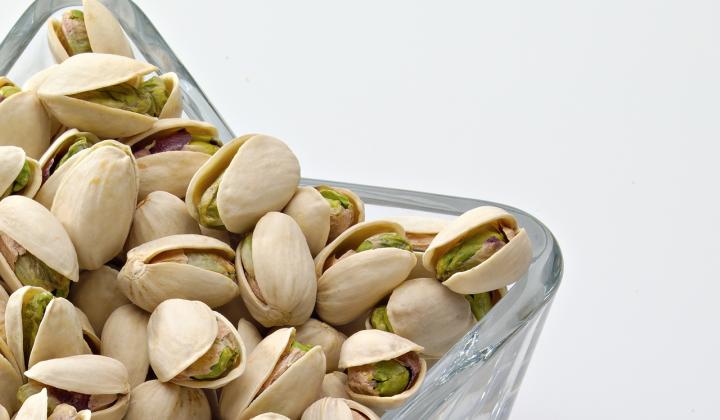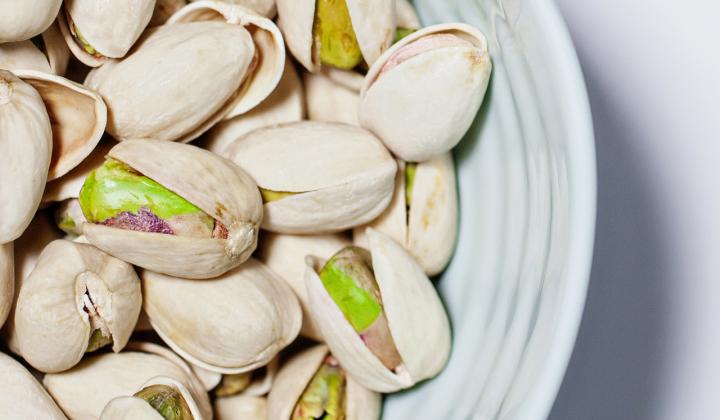Role of California pistachios in Athlete’s Diet
According to the Australian Institute of Sport (AIS), well-planned eating practices help athletes to train hard, stay healthy and injury-free, and maximise their performance. An ideal athletic diet should contain well-balanced portions of macronutrients (protein, carbohydrates and fat), micronutrients (vitamins and minerals) and fluids. Nuts and seeds are health-promoting foods that go hand in hand for their nutritional significance. These super-crunchy, fulfilling foods are excellent sources of fibre, protein, high quality fats and antioxidants. They contain a chockful of essential vitamins and minerals. Nuts and seeds are portable, versatile and environment friendly. Being an excellent source of “plant proteins”, nuts and seeds are best suitable for “vegan” athletes to meet their nutritional demands. Throwing some nuts (such as walnuts, pistachios, almonds, hazelnuts, etc.) and seeds (such as chia, sunflower and flax seeds etc.) into your salads, smoothies, desserts or any food preparations offer a range of cardio-protective, blood sugar- lowering, anti-ageing, gut-healthy, anti-inflammatory and anti-cancerous perks to the body. (Ros, 2010)
Pistachio nuts are edible seeds of Pistacia vera tree, containing a wholesome punch of nutrients that promote heart health and gut health, control blood sugar, blood pressure and blood cholesterol and are ideal for weight loss. These ‘green nuts’ are a rich source of proteins, antioxidants and fibre. Ever wondered? Pistachios are eaten by humans since 6000BC.
Here are some reasons why crack opening these nuts make a wholesome binge for athletes:
- RICH IN PROTEINS
Protein is the foremost important nutrient for athletes that aids in muscle repair and recovery and hinders muscle tissue damage. Pistachios are a good source of vegetable proteins (21gm/100 gm). Also, they contain a proportionally higher amount of essential amino acids than any other nuts. A non-essential aminoacid, L-arginine present in these nuts plays a key role in dilating the blood vessels by changing into nitric oxide, and improving blood circulation in athletes. (Hernández-Alonso P, 2016)
According to Sousa M et al, a combined intake of carbs and proteins coupled with antioxidants promote muscle repair and recovery after an exercise-induced muscle damage. Consuming a handful of pistachios along with any other “carbs rich” food 15 to 20 minutes post-workout would make up an ideal snack for athletes. (Sousa M, 2014)
- RICH IN ANTIOXIDANTS
Oxidative stress and inflammation are the “top” reasons for reduced performance among athletes, which lead to a decline in muscular activity and delayed recovery. Antioxidants have been documented to help with muscle recovery. Pistachios contain a plethora of antioxidants such as gamma-tocopherol (a type of vitamin E), polyphenols, and the carotenoids lutein and zeaxanthin. A randomised, cross-control study of 28 hypercholesterolemic patients who were on a pistachio-enriched diet for 4 weeks had higher levels of lutein and gamma-tocopherols compared to control group who did not consume pistachios.
Lutein and zeaxanthin give green colour to the nuts and promote eye-health by preventing age-related macular degeneration. Good news is that around 90% of antioxidants present in pistachios are well absorbed in the gut.
- RICH IN ESSENTIAL VITAMINS AND MINERALS
Pistachios are a rich source of vitamin A, B- vitamins (excluding B12), vitamin E, potassium, copper, magnesium and phosphorus. (Bulló M, 2015)
B-complex vitamins benefit the athletes by playing a key role in energy metabolism and formation of haemoglobin, which facilitates oxygen transport during exercise.
Potassium is an important electrolyte for athletes that regulates total body water and muscle contractions. During intense exercise, excess K is lost through sweat, instigating fatigue and muscular weakness. A single ounce of pistachios contains as much potassium as half a banana, which help replenish potassium stores in the body, coupled with proper hydration.
Magnesium and Phosphorus, being other minerals present in considerable amounts promote bone remineralization, post-contractile muscular relaxation and improved aerobic capacity among athletes. (Clarkson PM, 1995)
Pistachios also contain Zinc and Selenium in significant amounts, which are potent antioxidants important for muscle repair and recovery. (The Power of Pistachios)
- HELPS IN WEIGHT MANAGEMENT
Nuts are considered to be the energy-dense foods on earth, luckily, pistachios are one among the low-calorie nuts. Many promising studies have shown that pistachios can go a long way in controlling the body weight of athletes and active people. A 12-week weight loss program showing people who ate 53g of pistachios as an afternoon snack had twice the reduction in body mass index compared to those who ate 56g of pretzels. (Li Z, 2010)
Pistachios contain a generous amount of proteins and fibre that induce satiety and prevent overeating. Additionally, the MUFA and PUFA of pistachios can induce a higher thermogenic effect that can lead to less fat accumulation in the body. Another evidence also shows that fats from nuts are poorly absorbed, so the calories you get from eating pistachios would be comparatively less than predicted. (Baer DJ, 2012)
- REGULATION OF BLOOD GLUCOSE
Eating a low- GI (glycaemic index) carbohydrate food before exercise has been documented to prevent premature fatigue in athletes and positively impact performance. Low-GI meals improved carbs availability and increased the endurance of cyclists undertaking moderate intensity exercise. (FACT SHEET- The Glycaemic Index and Sports Performance, 2009) Owing to the rich contents of proteins, high quality fats and fibre, pistachios (low-GI) prevent immediate spike in blood glucose and help in continuous supply of energy throughout the exercise. A study showed that eating pistachios along with carbohydrate rich foods such as pasta, rice or white bread significantly reduced post prandial glucose levels. (Kendall CW, 2011) (Parham M, 2014)
- GOOD FOR YOUR GUT
A randomised, controlled, cross-over feeding study showed that eating pistachios has more positive benefits on gut microbiota than almonds. Pistachio consumption increased the number of potentially beneficial “butyrate-producing bacteria” without affecting bifidobacteria in the gut. (Ukhanova, Wang, Baer, & Novotny, 2014) Dr Mark Hyman says, “Gut health literally affects your entire body.” Healthily functioning digestive system is essentially integral for the better performance of athletes.
One serving size of pistachios is one ounce or about 49 kernels. These super-crunchy, satisfying nuts are an ideal and handy post-workout snack for athletes and fitness enthusiasts which supplies the body with energy and important nutrients it needs to replenish after an exercise. Even though the calories in these nuts are concentrated, regular consumption will not put you on the higher end on the weighing scale and does not lead to a higher body mass index. Rather, pistachios are good for your heart, brain and your entire body.
REFERENCES
Alan Christianson, N. (n.d.). Essential Nutrients for Endurance Athletes: 10 for the Road. Retrieved from Chirowebs.net: https://chiro.org/nutrition/FULL/Essential_Nutrients_for_Endurance_Athletes.shtml
Baer DJ, G. S. (2012). Measured energy value of pistachios in the human diet. Br J Nutr, 120-5.
Bulló M, J.-F. M.-A.-S. (2015). Nutrition attributes and health effects of pistachio nuts. Br J Nutr., 79-93.
Clarkson PM, H. E. (1995). Exercise and mineral status of athletes: calcium, magnesium, phosphorus, and iron. Med Sci Sports Exerc., 831-43.
FACT SHEET- The Glycaemic Index and Sports Performance. (2009). Retrieved from Sports Dietitians Austrailia: https://www.sportsdietitians.com.au/wp-content/uploads/2015/04/GI_and_sports_performance.pdf
Hernández-Alonso P, B. M.-S. (2016). Pistachios for Health. What Do We Know About This Multifaceted Nut? Nutrition Today, 133-138.
Hyman, M. How to Tend to Your Inner Garden – Why Your Gut Flora May be Making You Sick. Retrieved from drhyman.com: https://drhyman.com/blog/2014/10/10/tend-inner-garden-gut-flora-may-making-sick/
Kay CD, G. S.-E. (2010). Pistachios Increase Serum Antioxidants and Lower Serum Oxidized-LDL in Hypercholesterolemic Adults. The Journal of Nutrition, 1093-1098.
Li Z, S. R. (2010). Pistachio nuts reduce triglycerides and body weight by comparison to refined carbohydrate snack in obese subjects on a 12-week weight loss program. J Am Coll Nutr. , 198-203.
Parham M, H. S. (2014). Effects of Pistachio Nut Supplementation on Blood Glucose in Patients with Type 2 Diabetes: A Randomized Crossover Trial. Rev Diabet Stud., 190-96.
Ros, E. (2010). Health Benefits of Nut Consumption. Nutrients, 652-682.
Sousa M, T. V. (2014). Dietary strategies to recover from exercise-induced muscle damage. Int J Food Sci Nutr., 151-63.
The Power of Pistachios. (n.d.). Retrieved from AmericanPistachio.org: https://americanpistachios.in/sites/default/files/inline-files/Health-and-Nutrition-Research-Brochure.pdf
Tomaino A, M. M. (2010). Antioxidant activity and phenolic profile of pistachio (Pistacia vera L., variety Bronte) seeds and skins. Biochimie., 1115-22.
Ukhanova, M., Wang, X., Baer, D. J., & Novotny, J. (2014). Effects of almond and pistachio consumption on gut microbiota composition in a randomised cross-over human feeding study. British Journal of Nutrition.












